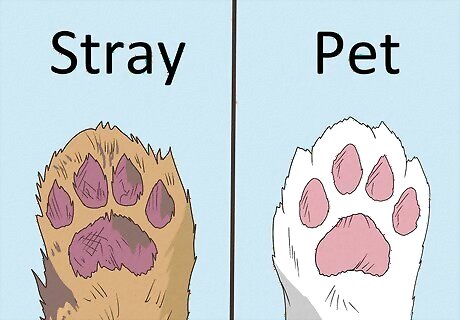
views
Approaching or Capturing a Cat

Tell the difference between a stray and a pet. Both lost strays and outdoor pets can be skittish or friendly, so it's hard to tell from behavior. The cat is probably a stray if its fur is messy or dirty, or if it looks skinny or injured. If the cat lets you touch it, check the paw pads. Stray cats that have lived outdoors for a few weeks will have hard, calloused feet compared to the soft paws of a family pet. If the cat tries to hide, doesn't look at you, and doesn't meow, it might be a feral cat, that was never a pet. Keep an eye out for lost cat notices on store windows and telephone poles in your neighborhood, and in local newspapers and websites. Be extra vigilant in winter. Strays are desperate for shelter and food at this time, and pets are unlikely to spend much time outside. Fresh tracks after a snowfall are an easy way to track strays if you get up before heavy traffic begins.

Try to approach the stray. If you think the cat is a stray, approach slowly while speaking in a soft voice. If the cat acts skittish, try bending down to its level. Hold out your hand and call it with a sweet voice. If that doesn't do it, return to the area later with a strong-smelling food, like tuna or dried liver. Try different tones or pitches, as some cats respond better to a higher or lower voice, or even ‘meow’ sounds. Don't get too close if the cat seems tense or nervous. If the cat feels cornered, it may bite or scratch.

Check for tags. If the cat has tags and lets you get close enough to read the phone number or address, contact the owners to find out whether the cat is supposed to be outside. Some tags have the contact info for a veterinary clinic instead. The vet may not be legally allowed to give you the owner's contact info, but they can pass on a message.

Provide shelter, water, and catnip for a potential stray cat. This may help to keep a lost cat near you until you can assist it. Place the food outdoors very late at night, in a small space that a cat could access but a larger animal could not. In sub-zero temperatures, oil from a tin of sardines poured over kibble works well. Do not leave food out until you suspect you have a stray, since this may just attract wildlife or feed other people's pets (who may be on controlled diets).

Consider contacting a professional. If you cannot approach the cat, you could ask Animal Control or a local animal shelter to capture it. Find out their policies before you make the call, especially if the cat does not have tags. Many shelters euthanize cats that do not seem adoptable. Others offer a more humane trap-neuter-release (TNR) program, so the cat returns outside but doesn't grow the feral cat population. Shelters generally offer a better chance at a good life for strays than they find on the streets. In a shelter, the cat will not die of starvation, injuries, or exposure.

Set a trap yourself. If you would rather catch the cat yourself, buy a humane cat trap from a hardware store, or ask animal control if they have any available for loan. Cover the trip plate and wire bottom of the trap with newspaper, so that the cat won't instinctively avoid stepping on the trip plate. Bait the trap with a small amount of strong-smelling food. Herring, mackerel, or sardines canned in oil (but not pickled) are excellent choices. Do not set the trip plate on a hair trigger. If the cat triggers it prematurely and escapes, it may never come back. It's better to risk the plate not going off, since you can put out more bait and try again. Too much food will create a mess if the cat panics and scatters it or vomits. In exceptionally cold weather, cover the trap with a sheet or towel, then heap snow over this covering to help keep the cat warm and calmer once it has been trapped.

Check the trap frequently but carefully. Check the trap as often as possible, but approach slowly to avoid scaring away the cat at the wrong moment. If the trap doesn't work in a day or two, try this longer-term approach: Disable the trap. Every day at the same time (preferably dusk), put out food near the trap. Gradually move the feeding spot closer to the trap, and eventually inside it. If the cat won't go inside, try covering the trap with a towel sprayed with cat pheromone spray. Once the cat is eating consistently inside the trap, set it to trigger.

Decide what to do with the cat once it is trapped. Once you have captured the cat, contact a local shelter to ask about local laws. In some areas, you are required to take lost pets to a shelter so the owner has a chance to find it. Make a decision based on the shelter's response and on the cat's appearance: If you do not plan to look after the cat at home, arrange in advance for a shelter or animal control agency to pick up the cat. Keep the cat in the trap in a quiet, dark area while it waits. Minimize the amount of time the cat has to wait, as this is extremely stressful for the animal. A stray pet tends to have a dirty coat, and a tendency to meow and make eye contact. It may eventually relax, come up to the front of the cage, or investigate toys or people that come near the cage. Continue on for advice on finding the owner or adopting it yourself. A feral (untamed) cat typically stays in the far back of the cage, may shake or bang the walls, and ignores toys and people. Learn more about how to handle the animal, along with other ways to confirm that it really is feral.
Caring For a Stray Cat

Handle with maximum caution. Even a friendly cat often panics in a trap. Wear heavy gloves when near the cat, and have a thick towel or blanket ready to throw over the cat if it tries to attack you. Avoid picking it up whenever possible; even if you avoid bites and scratches, the cat may resent the person who handles it.If absolutely necessary, transfer the cat to a carrier as follows:1. Set the carrier on its end, with the door at the top.2. Get behind the cat and scruff it firmly at the neck with your dominant hand.3. Push down on the cat's back immediately with your other hand, until you can get hold of both back legs.4. Stretch your arms apart as far as you can, lift the cat, and put it rear-end-first into a carrier.5. Quickly close the door on top of the cat. Hold the door down with one hand and brace the carrier between your legs until you have latched the door securely.

Set up a safe place for the cat to stay. Ideally, the room should be escape-proof, quiet, unused, easily cleaned, and almost completely empty. Spare bathrooms and fully-enclosed porches work well. Keep the following in this room: A comfortable seat for you to sit in quietly while the cat becomes used to you. A comfortable hiding place where the cat has a good view of the room. A cat carrier on a high shelf works well. Water Litter You can include a scratching post, toys, and a (closed) window, but the cat may be too stressed to use them.

Release the cat carefully. Wear gloves and position the trap or carrier away from you when you let the cat out. Most cats will scurry right into the hiding spot, but some will attempt escape. Keep the door closed. Cats can move very quick and may jump over you to reach the exit.

Isolate the cat from other animals in the home. Your safe room should have zero access to the other animals in your household, including being able to smell each other under doors, as disease can pass this way. Change your shoes and clothing and wash your hands and other exposed skin whenever you leave the safe room, to prevent transferring disease to other animals. Cats can transmit diseases to humans as well. If the cat bites you, wash the wound with soap and water and ask your doctor immediately about the risk of rabies, which is fatal without a prompt vaccine. If the cat scratches you, wash with soap and water and visit the doctor if the area becomes red or swollen, or if you get swollen lymph nodes, a headache, fever, or exhaustion.

Allow the cat to calm down for a few hours. Once it has calmed down a bit, enter the room quietly, bringing food and a camera. Try to get a good look at the cat, and ideally a good photo, so you can immediately begin to search for an owner. Aggression is not likely, but leave immediately if you notice these warning signs: flat ears; visible eye whites or extra-wide pupils; a crouched, tensed appearance; or slow movement toward you with the head down. Hissing and low growling with no other warning signs means the cat is afraid. Don't approach, but don't be scared of an attack either.

Try to locate the owner. Start searching for the cat's owners as soon as possible. If the cat doesn't have tags, try these methods: Tell your neighbors. Have a vet scan for a microchip ID. Call local shelters and ask if anyone has called in a lost cat matching this one's description. Put up flyers with the word FOUND in large font over a photo of the cat's face. Check the Lost section of local newspapers. You may be able to place a Found ad for free. Avoid sharing identifying details beyond the cat's color or pictures of the face.

Respond to potential owners. If someone calls you in response to your efforts, quiz them on the cat's sex or markings to confirm the owner's identity. If the cat has no telltale identifying markers, ask for a vaccination or medical record that includes a description of the cat, or for the contact details of the veterinarian. Although unlikely, there is a chance that an unethical caller will pretend to be the owner so they can sell the cat or adopt it for free. If the cat has not been vaccinated or neutered/spayed (and escaped at an age when it should have been), consider notifying a shelter about the situation. The shelter may be willing to accept the cat and require the owners to have these medical procedures done before returning the animal.

Feed and care for the cat on a regular schedule. Always bring the food in personally and, if the cat will allow, sit in the room while the cat eats. Food is your best tool to earn trust. Allow it to eat alone if it will not eat in your presence, but be sure it sees that you provide the food. A predictable routine will allow the cat to anticipate your visits, making your entry much less frightening and helping associate you with food. Sit in your chair and read quietly for a few minutes, at least a few times a day. Try to be as non-threatening as possible: move slowly, stay as 'small' as you can by hunching over, do not make eye contact, close your eyes and pretend to sleep, and speak quietly or not at all.

Try to touch the cat. It may take two or three weeks of several brief, daily interactions before the cat acts calm and eats well around you. Once you're at this point, slowly extend your hand to place an extra-tasty treat near the cat. Get the treat as close to the cat as you can before it cringes, growls, or otherwise acts threatened. Do not throw the treat or extend your fingers. Repeat, bringing your hand closer as the cat allows. Eventually, you may be able to bring your hand near enough that the cat will smell it. Allow this, then retract your hand. If the cat approaches, try slowly petting the shoulder blades, or whichever area the cat rubs against you. Go slowly, as the cat may have a sensitive injury. Pay attention to the cat's body language. Most strays will allow you to touch them once they've calmed down, and virtually all will give a warning signal if they are uncomfortable. (You may be able to ignore a brief hiss as long as it doesn't continue or escalate into a growl.) There is a significant risk of injury if the cat is actually feral. If the cat has no collar and it has not meowed or approached you, check for signs of a feral.

Adopt the cat yourself. If you have made a reasonable effort to find the owner (required by law in some areas), and no one has responded after a month, you could adopt the cat or give it to a shelter. If you decide to let the cat join your household permanently, follow these steps: Have a veterinarian perform a physical check up, test for feline leukemia, FIV, feline distemper, rabies, and worms, and vaccinate or treat as needed. Do not allow the cat to contact other pets in your house until this is done, not even by touching the same clothing. If the cat is not fixed, have it spayed or neutered to improve its health and behavior. Look for low-cost spay/neuter clinics if the cost is a burden. Gradually introduce the cat to the rest of the house and its members, one room or animal at a time.
Handling a Feral Cat

Confirm the cat is feral. Feral cats were never pets, and have not learned to meow or make eye contact with humans. Their coats are usually clean and well-kept compared to strays', since feral cats are used to taking care of themselves. Also look for these tell-tale signs: Feral cats found alone are often unneutered males (tomcats). These have a more muscular, stockier build and fuller cheeks than neutered pets. Some tomcats have a spiky coat and a greasy or hairless area at the base of the tail ("stud tail"). One clipped ear tip is the international sign of a spayed or neutered feral. Female ferals often live in small colonies around dumpsters or other food sources. When found alone, they can be difficult to tell apart from strays. A pregnant or lactating cat (with enlarged nipples and breasts) is usually feral.

Have the cat fixed. If the cat does not have a clipped ear, take it to the vet to be spayed or neutered. Always fix the cat before release so it displays fewer obnoxious behaviors (such as spraying or howling) and does not increase the feral cat population. If the shelter or vet clinic is part of a trap-neuter-release (TNR) program, it might perform the surgery for free. Bring the cat to the clinic promptly so the cat is not confined to the trap for more than 12 hours. If you decide to become more involved in a TNR program, invest in a transfer cage. This is a trap and cage with doorways that hook together, so the cat can walk into the larger space without escaping. You can also learn to tell whether the cat is fixed directly: follow these guides for female and male cats. Since this often requires handling the cat, it is not recommended until you have experience under trained supervision.

Keep the cat overnight. Cats usually need 24 hours to recover from the surgery, but some females take 48. Keep the trap or cage covered and move it to a temperature-controlled room, since cats recovering from anesthesia cannot regulate body temperature. Keep the room as quiet as possible and do not allow any other people or pets to enter. Monitor the cat closely: Feed kittens shortly after they wake up, and adult cats eight hours after they wake up. To do this, open a small gap in the trap door and slide in a little food and water on a plastic lid, without putting your hand inside. If you cannot do this safely, don't do it; the cat will manage. The cat might not eat right away. Call the clinic's emergency number (or the number they asked you to call) if the cat is bleeding, has trouble breathing, vomits, or does not wake up. If the cat vomits while asleep, gently tip the trap at a slight angle so the vomit runs away from the cat's throat.

Release the cat. An adult feral cat can almost never be socialized enough to become an indoor pet. Bring the trap back to the same location you trapped it, open it, and wait until the cat walks out on its own. Disinfect and rinse the trap thoroughly before using it for another animal. If you do not want the cat living in your neighborhood, take it to a shelter. Cats rarely do well when released in a new location, but shelter staff should know how to increase the chance of success.

Assist the feral cat. If you would like to help the cat, you can leave out food and water near the location where you trapped it. Feral cats are especially vulnerable in cold climates, and may benefit from a shelter and a source of liquid water (a heated water bowl) in winter.

Tame the feral cat. If the cat shows some friendliness toward humans, or is no more than four months old, it may be possible to adopt it as a semi-tamed pet. The first step is to take it to a veterinarian for deworming and vaccinations. After that, a slow introduction to your household, one room at a time, may succeed in socializing the animal. Keep in mind that this is very difficult for fully feral, adult cats, and you may need to release the cat if it doesn't work out.

















Comments
0 comment